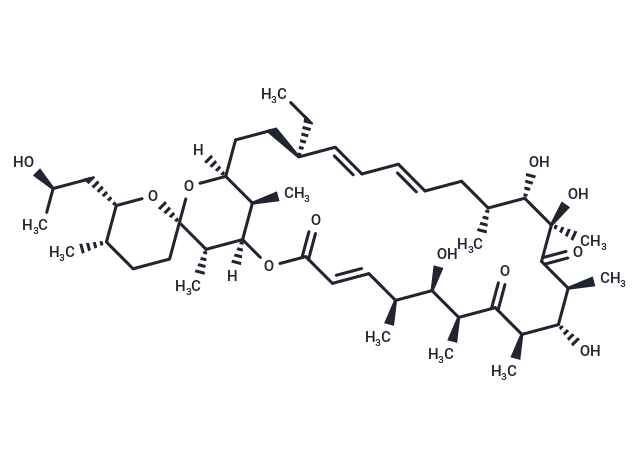Shopping Cart
- Remove All
 Your shopping cart is currently empty
Your shopping cart is currently empty

Oligomycin A (MCH 32) is an inhibitor of ATP synthase, inhibits oxidative phosphorylation and all the ATP-dependent processes occurring on the coupling membrane of mitochondria.

| Pack Size | Price | Availability | Quantity |
|---|---|---|---|
| 1 mg | $128 | In Stock | |
| 5 mg | $211 | In Stock | |
| 10 mg | $345 | In Stock | |
| 25 mg | $583 | In Stock | |
| 50 mg | $833 | In Stock | |
| 1 mL x 10 mM (in DMSO) | $245 | In Stock |
| Description | Oligomycin A (MCH 32) is an inhibitor of ATP synthase, inhibits oxidative phosphorylation and all the ATP-dependent processes occurring on the coupling membrane of mitochondria. |
| Targets&IC50 | F0F1-ATPase:1 μM(Ki) |
| In vitro | METHODS: Human melanoma cells WM3734 were treated with Oligomycin A (0.01-1 µg/mL) for 24 h, and lactate production was measured in culture supernatants. RESULTS: Oligomycin A caused an increase in lactate production in WM3734 cells. [1] METHODS: Human lung cancer cells H1299 were treated with Oligomycin A (0.1-1000 ng/mL) for 100 min, and cellular respiration was measured using Oxygen Biosensor System plates. RESULTS: At 100 and 1000 ng/mL, Oligomycin A completely inhibited cellular respiration within approximately one hour. [2] |
| In vivo | METHODS: To assay anti-inflammatory activity, Oligomycin A (0.25 mg/kg) was injected intraperitoneally into C57BL6 mice in a psoriasis model once daily for five days. RESULTS: Oligomycin A reduced ear thickness, keratinocyte proliferation and immune cell infiltration. [3] |
| Cell Research | ATP and Oligomycin Dose-Response Growth Measurement. Cellular ATP changes are measured by CellTiter-Glo reagent. To measure oligomycin dose-response curves, the cells are plated in 96-well plates at about 400–500 cells/well in 100 μl of culture, dosed the next day, and grown for 4 additional days followed by assaying with Cell-Titer-Glo reagent. The dose-response curves are plotted with nonlinear regression analysis of GraphPad Prism.(Only for Reference) |
| Alias | MCH 32 |
| Molecular Weight | 791.06 |
| Formula | C45H74O11 |
| Cas No. | 579-13-5 |
| Smiles | [H][C@]12CC[C@@H](CC)\C=C\C=C\C[C@@H](C)[C@H](O)[C@@](C)(O)C(=O)[C@@H](C)[C@H](O)[C@@H](C)C(=O)[C@@H](C)[C@H](O)[C@@H](C)\C=C\C(=O)O[C@]([H])([C@@H]1C)[C@H](C)[C@@]1(CC[C@H](C)[C@H](C[C@@H](C)O)O1)O2 |
| Relative Density. | 1.14g/cm3 |
| Storage | store at low temperature,keep away from moisture | Powder: -20°C for 3 years | In solvent: -80°C for 1 year | Shipping with blue ice. | ||||||||||||||||||||
| Solubility Information | DMSO: 10 mg/mL (12.64 mM), Sonication is recommended. Ethanol: < 1 mg/mL (insoluble or slightly soluble) H2O: < 1 mg/mL (insoluble or slightly soluble) | ||||||||||||||||||||
Solution Preparation Table | |||||||||||||||||||||
DMSO
| |||||||||||||||||||||

Copyright © 2015-2025 TargetMol Chemicals Inc. All Rights Reserved.